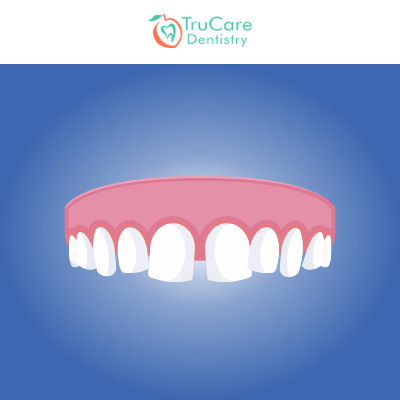
The gap between two teeth is known as a diastema. Kids do not need treatment for the same. In adults, it’s normal to have minor gaps. However, large and clearly-visible ones need attention. Finding the cause and closing the gap is always better.
Yes, there are several options to fill these spaces without invasive oral surgery. After considering the gap size, dental care professionals choose the filling material and treatment option. Let’s look at the seven of the most appreciated methods.
Dental bonding with tooth-colored resin
Dental bonding remains the most preferred option for fixing gapped teeth. The process is simple. Dentists clean all teeth and apply a tooth-colored resin on the surfaces. Then, a special blue light is applied to the resin layer to harden it. That’s it. Your broken or chipped teeth start appearing normal. The bonding material is stain-resistant. But patients need to follow proper oral hygiene for a long-lasting white smile.
Dental bonding costs less than other options. You can expect the shield to last for five to ten years.
Veneers
Veneers are wafer-like thin shells that are custom-made to fit your front teeth. They easily conceal gaps and cracks because they are wider than the teeth surfaces.
Dentists use bonding material to fix veneers on the tooth surface. In some cases, a small portion of tooth enamel is removed to ensure the shell fits perfectly.
Your dentist will choose between composite and porcelain veneers depending on teeth shade and condition. Your teeth appear natural because veneers match your tooth color. They are a bit costly but last for ten years or more
Invisalign or Braces
Braces do not need an introduction. They reduce the gaps between teeth by applying tension and pulling them together.
Traditional metal braces have been around for several decades. They are a crucial element in orthodontic treatment. However, there are alternatives like self-ligating braces, lingual and ceramic ones for those who do not like metal.
Braces are suitable to fix significant gaps, jaw alignment, correcting the bite, and straightening crooked teeth. In addition, they can bring all your teeth to the designated position.
If you don’t want people to know you are wearing braces, Invisalign clear aligners are the thing for you. These dental devices are custom-made to fit and can close gaps without showing their presence. You can remove them while eating or sleeping.
Traditional metal braces-based treatment needs six months to a few years to fix the position of teeth. The duration increases even further if you choose Invisalign aligners.
Dental crowns
Dental crowns are designed to cover damaged teeth and restore their chewing ability. Depending on the type of the gap, sometimes custom-made dental crowns prove perfect to fill the void.
Implants
Diastema caused due to missing teeth needs something more than veneers or dental bonding. Gaps between teeth are so significant that even braces do not help. For such cases, dentists recommend closing the gap with a dental implant.
A dental surgeon fixes a titanium screw (artificial tooth root) in the gum and jawbone. Later, once the artificial root integrates with gums, a crown is fitted on the screw to give it a natural tooth-like appearance.
In case of missing bone support, skilled professionals perform dental bone graft surgery before placing an implant. Besides taking care of the empty space, an implant also restores the patient’s chewing ability and jawbone support.
Frenectomy surgery
An oversized labial frenum (excess tissue) can result in diastema. The most suitable treatment to remove the excess tissue is the frenectomy procedure. Post-surgery, orthodontists recommend braces or aligners-based treatment for closing the gap in adults. While in kids, this gap closes on its own. So, there’s no need for braces.
Gum disease treatment
Gum disease also results in diastema. Merely filling gaps does not help in such cases. Thus, dentists first treat the infection to prevent further damage, including tooth loss.
Patients might need scaling for tartar removal. If required, decayed and infected teeth are extracted. The treatment plan for such patients also includes antibiotics to control the infection. Once the condition is clear, the dentist can recommend an implant or other space-filling options.
Most reported types of gaps
- Gaps between front teeth
- Space between side teeth
- Gaps between all teeth
- Space between canines on only one side
Is there a way to prevent the formation of such gaps?
You can undoubtedly prevent diastema caused due to poor oral hygiene and gum disease. Adults can simply follow a daily brushing and flossing routine. Opt for a quarterly or six-monthly dental cleaning and oral health examination.
Visit your dental clinic immediately if you experience improper swallowing reflexes. If you opt for tooth extraction, ask the dentist to fill up the empty space with a bone graft or implant at a later stage.
For children, parents should ensure they avoid sucking their thumb or pressing the front teeth with their tongue.
Does insurance cover the treatment cost?
In most cases, policies cover costs if the procedure is crucial for health reasons rather than cosmetic ones. It’s best to confirm with your insurer before scheduling your treatment.
The endnote:
Are those gaps between teeth making you feel self-conscious? Do you need a diastema specialist in Roswell (GA)? Feel free to contact and fix an appointment at TruCare Dentistry. Let us examine your teeth and fill gaps with the best suitable method.
